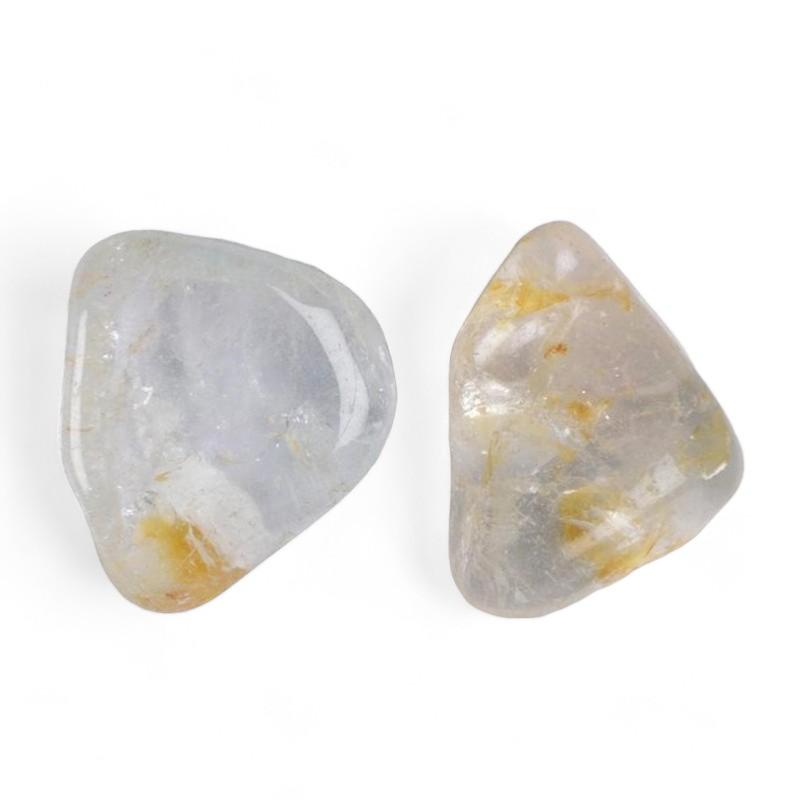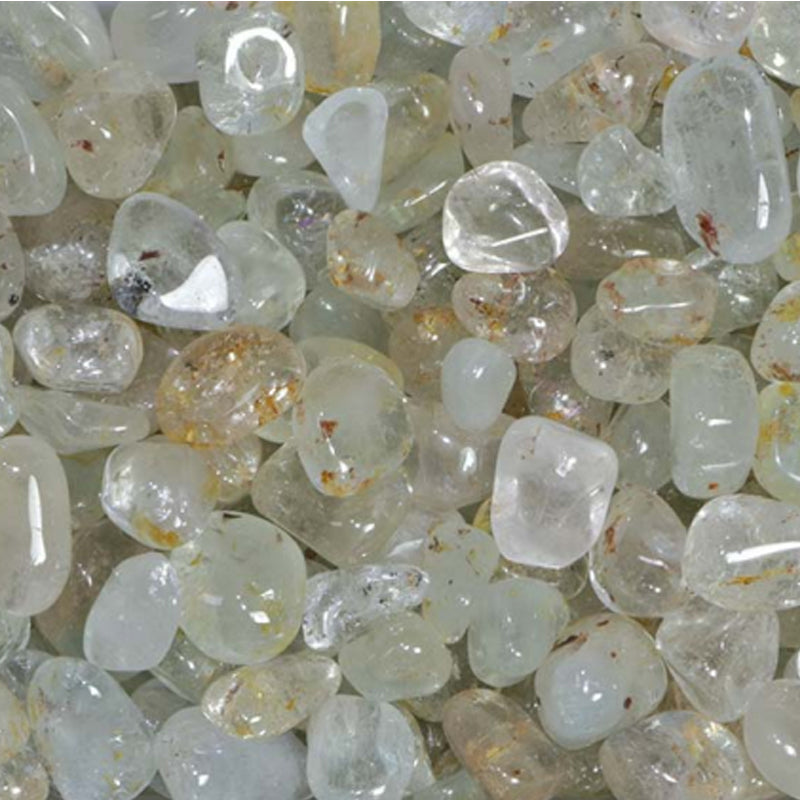1
/
of
2
White Topaz Nigeria A (tumbled stone)
TOPB-R-01
8c984efa-30a8-5524-41cc-ae7b332135e6
028d80eb-2b30-41d4-b221-bda49eca04cf
- Regular price
-
3,90€ - Regular price
-
- Sale price
-
3,90€
Tax included.
Shipping calculated at checkout.
Couldn't load pickup availability
Learn more
TOPB-R-01
Origin: Nigeria
Grade: A
Dimensions:
About 15-25mm
Weight:
Between 3 and 7g
Origin:
Nigeria
Grade:
A = good
Origin:
Nigeria
Grade:
A = good
Small 15-25mm white topaz tumbled stone. Sold individually.
Shapes and colors may vary from one stone to another.
Topaz is a fine stone used today in the creation of jewelry, but also in lithotherapy because of its many benefits.
The etymology of the name topaz is somewhat uncertain. It seems that the name topaz comes from the Greek "topos” and "azos” meaning "desert country". Topazos is the name given to a desert island in the Red Sea today called Zabargad.
Another explanation is that there is an Indian city called "Topaza". The name topaz comes from the Sanskrit word "tapaz" meaning "fire". This city was famous for its beautiful yellow and shiny stones.
Throughout civilizations, topaz has crossed the ages and various legends have been attributed to it. It is cited by the Roman naturalist Pliny the Elder (23-79 AD) and appears in the Bible as one of the famous stones adorning Aaron's breastplate.
In Asia Minor, during the 7th century BC, it is said that the king of Lydia, named Gyges, found a magic ring in the flanks of a bronze horse. On one side of this signet ring, we discover a sun carved on a topaz and on the other side, an image of the moon cut in an emerald. On this fabulous ring, words were engraved, which when spoken aloud, made one invisible. This ring was never found.
Very quickly, topaz was attributed protective properties and magical powers. During antiquity, it was nicknamed the gold stone, because it facilitated the mining of gold.
The Egyptians used this fabulous stone as talismans. It is said that Cleopatra offered a magnificent topaz to her lover Mark Antony. A magical intaglio from Alexandria was found, currently kept in the Cabinet des Médailles in Paris. This intaglio represents the god Helios driving the chariot of the sun. On the back, we discover indecipherable characters.
The Romans and Greeks used it as a protective stone that made one stronger and believed that it had the power to make one invisible. The Hebrews attributed power and invincibility to it.
In the Middle Ages, topaz was used to cure vision problems. It was immersed in a glass of wine for several days, then compresses soaked in this elixir were applied to the eyes. In 1348, topaz was said to have been used to save plague victims during the great Black Death epidemic. A topaz was mounted as a jewel and worn by Pope Clement VI.
Indian doctors used topaz to strengthen the heart and regenerate blood circulation, while the Chinese hung topaz in their homes to give them strength and good health.
Nowadays, we can say that topaz is part of the silicate family and the nesosilicate subclass. Blue topaz has a hardness of 8 on the Mohs scale, which represents a high hardness. In comparison, diamond has a hardness of 10, which is the highest on this same scale.
Topaz has an orthorhombic crystal system with a color that changes depending on its aluminum content or other elements, such as iron, cobalt or chromium. In fact, the color of the stone varies in transparency and translucency with tones ranging from yellow to green, pink or blue. Blue topaz can be light blue (Sky Blue), gray blue (London Blue) or bright blue (Swiss Blue).
The main deposits are located in Nigeria, Zimbabwe, Peru, Namibia, etc.
Blue topaz is a stone that promotes communication and speech. It provides clear and calm speech. The message gets across well. It allows you to open up to others and be sincerely interested in them. It can be the origin of lasting friendships. It promotes frankness and honesty. The person shows empathy and compassion.
This stone is recommended for people who are angry, suffering from jealousy and resentment. It promotes the control of emotions and their channeling. It brings a certain inner wisdom. In fact, it opens new perspectives and consolidates relationships with others. It encourages to be honest and faithful. It facilitates forgiveness and peace.
Topaz is highly recommended for artists and intellectuals. It develops artistic creation and the development of the intellect. It helps to maintain a certain flexibility of mind and to get rid of mental rigidities, preconceived ideas. It engenders optimism and allows decision-making. It removes fears and doubts. It is a stone that provides beautiful intuition.
This fabulous stone restores self-confidence and assurance. It is an excellent bulwark against negative emotions and feelings such as anguish, anxiety and unconscious fears.
Shapes and colors may vary from one stone to another.
Topaz is a fine stone used today in the creation of jewelry, but also in lithotherapy because of its many benefits.
The etymology of the name topaz is somewhat uncertain. It seems that the name topaz comes from the Greek "topos” and "azos” meaning "desert country". Topazos is the name given to a desert island in the Red Sea today called Zabargad.
Another explanation is that there is an Indian city called "Topaza". The name topaz comes from the Sanskrit word "tapaz" meaning "fire". This city was famous for its beautiful yellow and shiny stones.
Throughout civilizations, topaz has crossed the ages and various legends have been attributed to it. It is cited by the Roman naturalist Pliny the Elder (23-79 AD) and appears in the Bible as one of the famous stones adorning Aaron's breastplate.
In Asia Minor, during the 7th century BC, it is said that the king of Lydia, named Gyges, found a magic ring in the flanks of a bronze horse. On one side of this signet ring, we discover a sun carved on a topaz and on the other side, an image of the moon cut in an emerald. On this fabulous ring, words were engraved, which when spoken aloud, made one invisible. This ring was never found.
Very quickly, topaz was attributed protective properties and magical powers. During antiquity, it was nicknamed the gold stone, because it facilitated the mining of gold.
The Egyptians used this fabulous stone as talismans. It is said that Cleopatra offered a magnificent topaz to her lover Mark Antony. A magical intaglio from Alexandria was found, currently kept in the Cabinet des Médailles in Paris. This intaglio represents the god Helios driving the chariot of the sun. On the back, we discover indecipherable characters.
The Romans and Greeks used it as a protective stone that made one stronger and believed that it had the power to make one invisible. The Hebrews attributed power and invincibility to it.
In the Middle Ages, topaz was used to cure vision problems. It was immersed in a glass of wine for several days, then compresses soaked in this elixir were applied to the eyes. In 1348, topaz was said to have been used to save plague victims during the great Black Death epidemic. A topaz was mounted as a jewel and worn by Pope Clement VI.
Indian doctors used topaz to strengthen the heart and regenerate blood circulation, while the Chinese hung topaz in their homes to give them strength and good health.
Nowadays, we can say that topaz is part of the silicate family and the nesosilicate subclass. Blue topaz has a hardness of 8 on the Mohs scale, which represents a high hardness. In comparison, diamond has a hardness of 10, which is the highest on this same scale.
Topaz has an orthorhombic crystal system with a color that changes depending on its aluminum content or other elements, such as iron, cobalt or chromium. In fact, the color of the stone varies in transparency and translucency with tones ranging from yellow to green, pink or blue. Blue topaz can be light blue (Sky Blue), gray blue (London Blue) or bright blue (Swiss Blue).
The main deposits are located in Nigeria, Zimbabwe, Peru, Namibia, etc.
Blue topaz is a stone that promotes communication and speech. It provides clear and calm speech. The message gets across well. It allows you to open up to others and be sincerely interested in them. It can be the origin of lasting friendships. It promotes frankness and honesty. The person shows empathy and compassion.
This stone is recommended for people who are angry, suffering from jealousy and resentment. It promotes the control of emotions and their channeling. It brings a certain inner wisdom. In fact, it opens new perspectives and consolidates relationships with others. It encourages to be honest and faithful. It facilitates forgiveness and peace.
Topaz is highly recommended for artists and intellectuals. It develops artistic creation and the development of the intellect. It helps to maintain a certain flexibility of mind and to get rid of mental rigidities, preconceived ideas. It engenders optimism and allows decision-making. It removes fears and doubts. It is a stone that provides beautiful intuition.
This fabulous stone restores self-confidence and assurance. It is an excellent bulwark against negative emotions and feelings such as anguish, anxiety and unconscious fears.
Features
Color :
- White
Astrological sign:
- Gemini
- Sagittarius
Stone Type:
- Rolled Stones
Age :
- Adults
Gender :
- Unisex



White Topaz Nigeria A (tumbled stone)
- Regular price
-
3,90€ - Regular price
-
- Sale price
-
3,90€
8c984efa-30a8-5524-41cc-ae7b332135e6
028d80eb-2b30-41d4-b221-bda49eca04cf
-
100% SECURE PAYMENT
Paypal, credit card, check, transfer
-
FREE DELIVERY
from 40€ purchase
-
SATISFIED OR REFUNDED
14 days to change your mind
-
CUSTOMER SERVICE AVAILABLE
contact@laboiteacailloux.com
Subscribe to our newsletter
to receive all our offers, good deals and new products from La Boite à Cailloux




